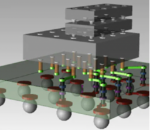First, a quick definition. By “structured assembly,” I mean the collection of tools to support IP packaging with standardized interfaces, SoC integration based on those IPs together with bus fabric and other connectivity hookups, register definition and management in support of hardware/software interface definition, … Read More
UCIe InterOp Testchip Unleashes Growth of Open Chiplet Ecosystem
Intel recently made headlines when CEO Pat Gelsinger unveiled the world’s first UCIe interoperability test chip demo at Innovation 2023. The test chip built using advanced packaging technology is codenamed Pike Creek and is used to demonstrate interoperability across chiplets designed by Intel and Synopsys. More details … Read More
Prototyping Chiplets from the Desktop!
S2C has been successfully delivering rapid SoC prototyping solutions since 2003 with over 600 customers, including 6 of the world’s top 10 semiconductor companies. I personally have been involved with the prototyping market for a good part of my career and know S2C intimately.
S2C is the leading independent global supplier… Read More
Successful 3DIC design requires an integrated approach
While the leap from traditional SoC/IC designs to Three-Dimensional Integrated Circuits (3DICs) designs brings new benefits and opportunities, it also introduces new challenges. The benefits include performance, power efficiency, footprint reduction and cost savings. The challenges span design, verification, thermal… Read More
Ensuring 3D IC Semiconductor Reliability: Challenges and Solutions for Successful Integration
One of the most promising advancements in the semiconductor field is the development of 3D Integrated Circuits (3D ICs). 3D ICs enable companies to partition semiconductor designs and seamlessly integrate silicon Intellectual Property (IP) at the most suitable process nodes and processes. This strategic partitioning yields… Read More
Managing IP, Chiplets, and Design Data
Design re-use has enabled IC design teams to create billion-transistor designs where hundreds of IP blocks are pre-built from internal or external sources. Keeping track of where each of these IP blocks came from, what their version status is, managing IP, or even discerning their license status can be a full-time job if tracked… Read More
The Path to Chiplet Architecture
If you have anything to do with the semiconductor industry, you already know that one of the hottest areas for both manufacturing and EDA are systems designed with advanced packaging, basically putting more than one die (aka chiplets) in the same package.
When 3D packaging was first introduced, there were not really any effective… Read More
Synopsys Panel Updates on the State of Multi-Die Systems
Synopsys recently hosted a cross-industry panel on the state of multi-die systems which I found interesting not least for its relevance to the rapid acceleration in AI-centric hardware. More on that below. Panelists, all with significant roles in multi-die systems, were Shekhar Kapoor (Senior Director of Product Management,… Read More
Disaggregated Systems: Enabling Computing with UCIe Interconnect and Chiplets-Based Design
The world of computing is evolving rapidly, with a constant demand for more powerful and efficient systems. Generative AI has driven exponential growth in the amount of data that is generated and processed at very high data speeds and very low latencies. Traditionally, computing systems have been built using monolithic designs,… Read More
SPIE- EUV & Photomask conference- Anticipating High NA- Mask Size Matters- China
– SPIE EUV & Photomask conference well attended with great talks
– Chip industry focused on next gen High NA EUV & what it impacts
– Do big chips=big masks? Another Actinic tool?
– AI & chip tools, a game changer- China pre-empting more sanctions











Quantum Computing Technologies and Challenges